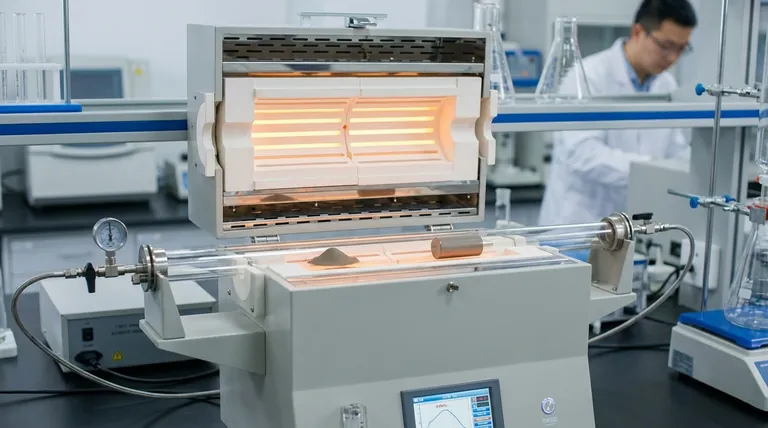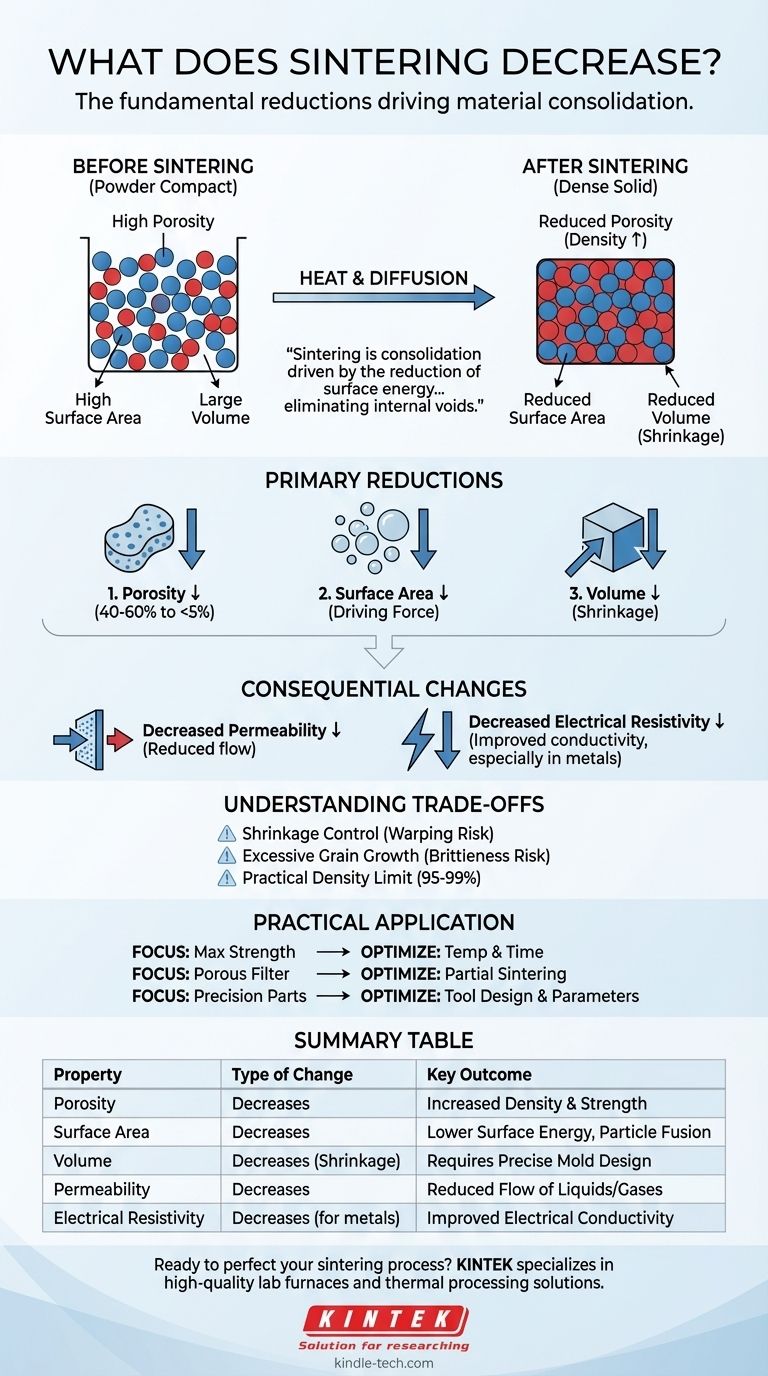At its core, sintering fundamentally decreases a material's porosity and surface area. This is the primary physical change that occurs when a mass of powder is heated below its melting point. The individual particles fuse together, eliminating the empty spaces (pores) between them and reducing the total exposed surface area of the material.
Sintering is a process of consolidation driven by the reduction of surface energy. By heating a powder compact, you cause particles to bond and grow, systematically eliminating the internal voids and transforming a loose collection of grains into a dense, solid object.

The Primary Reductions Caused by Sintering
Sintering is a transformative process. The decreases it causes are not incidental; they are the very purpose of the procedure, leading directly to the desired final material properties.
The Elimination of Porosity
The most significant change during sintering is the reduction of porosity. The initial powder compact can have a porosity of 40-60%, meaning nearly half its volume is just empty space.
As the material is heated, atoms diffuse across the boundaries of adjacent particles, forming solid "necks" between them. These necks grow, pulling the particles closer and systematically closing the pores, which dramatically increases the material's density.
The Reduction of Surface Area
The fundamental driving force for sintering is the reduction of surface area. A fine powder has an enormous amount of surface area for its mass, which corresponds to a state of high surface energy.
Nature favors lower energy states. By fusing, the small particles reduce their total surface area, just as small soap bubbles merge to form larger ones. This release of excess surface energy is what powers the entire consolidation process.
The Decrease in Overall Volume (Shrinkage)
A direct consequence of eliminating porosity is shrinkage. As the empty spaces between particles are removed, the entire component contracts and its overall volume decreases.
This shrinkage is a critical factor in manufacturing. Engineers must design the initial mold or "green body" to be larger than the final part to compensate precisely for the dimensional changes that will occur during sintering.
Consequential Changes in Material Properties
The primary reductions in porosity and surface area lead to several other important changes in the material's bulk properties.
Decreased Permeability
As the network of interconnected pores is closed off, the material's permeability drops significantly. This makes it more difficult for liquids or gases to pass through.
This property is intentionally controlled. For components like self-lubricating bearings, some porosity is retained to hold oil. For structural parts, the goal is to minimize permeability by eliminating as many pores as possible.
Decreased Electrical Resistivity
For conductive materials like metal powders, sintering typically decreases electrical resistivity. This means the material becomes a better conductor of electricity.
The initial powder compact has poor electrical contact between particles. Sintering creates solid, fused bonds, providing a much more efficient path for electrons to flow, thereby increasing conductivity and decreasing resistance.
Understanding the Trade-offs
While sintering is essential for creating strong materials from powders, the process involves critical trade-offs that must be carefully managed.
The Challenge of Shrinkage Control
Shrinkage is unavoidable but can be difficult to control perfectly. Non-uniform heating or density variations in the initial powder compact can lead to warping or cracking.
Achieving tight dimensional tolerances requires extremely precise control over powder characteristics, compaction pressure, heating rates, and sintering temperature.
The Risk of Excessive Grain Growth
If sintering is performed at too high a temperature or for too long, the grains can continue to grow even after most porosity is gone. This is known as grain growth.
While high density is desirable, excessively large grains can often make a material more brittle, reducing its toughness and strength. The ideal process achieves maximum density while maintaining a fine, strong grain structure.
The Practical Limit of Density
Achieving 100% of a material's theoretical density is often impractical or prohibitively expensive. Some tiny amount of residual porosity almost always remains trapped within the grains.
For most applications, reaching 95-99% of theoretical density is sufficient to achieve the desired mechanical properties.
How to Apply This Knowledge in Practice
Understanding what sintering decreases allows you to control the process to achieve a specific outcome.
- If your primary focus is maximum strength and density: You must optimize the sintering temperature and time to eliminate porosity without causing excessive grain growth.
- If your primary focus is creating a porous filter: You will use partial sintering at lower temperatures or for shorter times to create strong necks between particles while intentionally preserving a network of open pores.
- If your primary focus is manufacturing high-precision parts: You must master the art of predicting and controlling shrinkage through careful tool design and process parameter optimization.
Ultimately, knowing that sintering decreases porosity and surface area gives you the power to engineer a material's microstructure for optimal performance.
Summary Table:
| Property Changed by Sintering | Type of Change | Key Outcome |
|---|---|---|
| Porosity | Decreases | Increased density and strength |
| Surface Area | Decreases | Lower surface energy, particle fusion |
| Volume | Decreases (Shrinkage) | Requires precise mold design |
| Permeability | Decreases | Reduced flow of liquids/gases |
| Electrical Resistivity | Decreases (for metals) | Improved electrical conductivity |
Ready to perfect your sintering process and achieve optimal material properties?
KINTEK specializes in high-quality lab furnaces and equipment for precise thermal processing. Whether you're developing new materials or manufacturing precision components, our solutions help you control porosity, density, and grain structure with exceptional accuracy.
Contact our experts today to discuss how we can support your laboratory's sintering and materials science needs.
Visual Guide

Related Products
- 1400℃ Laboratory Quartz Tube Furnace with Alumina Tube Tubular Furnace
- Laboratory Muffle Oven Furnace Bottom Lifting Muffle Furnace
- 1800℃ Muffle Oven Furnace for Laboratory
- 1700℃ Laboratory Quartz Tube Furnace with Alumina Tube Tubular Furnace
- Laboratory Quartz Tube Furnace Tubular RTP Heating Furnace
People Also Ask
- What material are furnace tubes? Choosing the Right Material for High-Temperature Success
- How does a tubular furnace work? A Guide to Controlled High-Temperature Processing
- What precautions should be taken when using a tube furnace? Ensure Safe, Effective High-Temperature Processing
- What is the high temperature of a tube furnace? Unlock the Right Model for Your Application
- What is a tube furnace used for? Achieve Precise, Controlled Thermal Processing



















